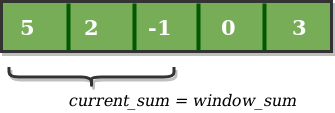Sliding Window Algorithm
The main idea behind the sliding window technique is to convert two nested loops into a single loop. Usually, the technique helps us to reduce the time complexity from O(n^2) to O(n).
The condition to use the sliding window technique is that the problem asks to find the maximum (or minimum) value for a function that calculates the answer repeatedly for a set of ranges from the array. Namely, if these ranges can be sorted based on their start, and their end becomes sorted as well, then we can use the sliding window technique.
Let’s start with a problem for illustration where we can apply this technique –
Given an array of integers of size ‘n’.
Our aim is to calculate the maximum sum of ‘k’
consecutive elements in the array.
Input : arr[] = {100, 200, 300, 400}
k = 2 Output : 700
Input : arr[] = {1, 4, 2, 10, 23, 3, 1, 0, 20}
k = 4 Output : 39
We get maximum sum by adding subarray {4, 2, 10, 23} of size 4.
Input : arr[] = {2, 3}
k = 3 Output : Invalid
There is no subarray of size 3 as size of whole array is 2.
So, let’s analyze the problem with Brute Force Approach. We start with first index and sum till k-th element. We do it for all possible consecutive blocks or groups of k elements. This method requires nested for loop, the outer for loop starts with the starting element of the block of k elements and the inner or the nested loop will add up till the k-th element.
// Java code here O(n*k) solution for finding
// maximum sum of a subarray of size k
class Test{
// Returns maximum sum in a subarray of size k.
static int maxSum(int arr[], int n, int k)
{
// Initialize result
int max_sum = Integer.MIN_VALUE;
// Consider all blocks starting with i.
for (int i = 0; i < n - k + 1; i++) {
int current_sum = 0;
for (int j = 0; j < k; j++)
current_sum = current_sum + arr[i + j];
// Update result if required.
max_sum = Math.max(current_sum, max_sum);
}
return max_sum;
}
// Driver code
public static void main(String[] args)
{
int arr[] = { 1, 4, 2, 10, 2, 3, 1, 0, 20 };
int k = 4;
int n = arr.length;
System.out.println(maxSum(arr, n, k));
}
}
It can be observed from the above code that the time complexity is O(k*n) as it contains two nested loops.
Window Sliding Technique
The technique can be best understood with the window pane in bus, consider a window of length n and the pane which is fixed in it of length k. Consider, initially the pane is at extreme left i.e., at 0 units from the left. Now, co-relate the window with array arr[] of size n and pane with current_sum of size k elements. Now, if we apply force on the window such that it moves a unit distance ahead. The pane will cover next k consecutive elements.
Consider an array arr[] = {5, 2, -1, 0, 3} and value of k = 3 and n = 5
Applying sliding window technique :
- We compute the sum of first k elements out of n terms using a linear loop and store the sum in variable window_sum.
- Then we will graze linearly over the array till it reaches the end and simultaneously keep track of maximum sum.
- To get the current sum of block of k elements just subtract the first element from the previous block and add the last element of the current block .
The below representation will make it clear how the window slides over the array.
This is the initial phase where we have calculated the initial window sum starting from index 0 . At this stage the window sum is 6. Now, we set the maximum_sum as current_window i.e 6.

Now, we slide our window by a unit index. Therefore, now it discards 5 from the window and adds 0 to the window. Hence, we will get our new window sum by subtracting 5 and then adding 0 to it. So, our window sum now becomes 1. Now, we will compare this window sum with the maximum_sum. As it is smaller we wont the change the maximum_sum.

Similarly, now once again we slide our window by a unit index and obtain the new window sum to be 2. Again we check if this current window sum is greater than the maximum_sum till now. Once, again it is smaller so we don’t change the maximum_sum.
Therefore, for the above array our maximum_sum is 6.

We can use this technique to find max/min k-subarray, XOR, product, sum, etc.
Comments
Post a Comment